My Namibia itinerary plays for my deep love for the continent of Africa.
Ever since I first set foot in Tanzania, I have been hooked on Africa. As such, whenever I’m asked what my favorite destination is, I always list Tanzania for the pure adventure. While there, I climbed Mount Kilimanjaro, went on four safaris, saw four of the big five, and got my Advanced Open Water Diver certification.
Naturally, a quick return to the wilds of Africa was in the cards. Africa, however, is a massive continent, so I wasn’t exactly sure where I should go. This, of course, led to many long sleepless nights of research, heated debates with myself the mirror, a Zoltar machine, Instagram, countless blog articles, and my TV’s image screensaver.
Okay, no.
How did I really decide? Someone posted an image on Instagram of #dune45; I checked the hashtag and said, “That looks like a cool thing to climb.”
Just like that.
Then, of course, because Google spies on us, my TV’s screensaver really did start showing me images of Deadvlei, and one of the only travel bloggers I follow decided to host a group trip there. Coincidentally, his trip was only one week before I was slated to arrive in-country.
My mind was made up.
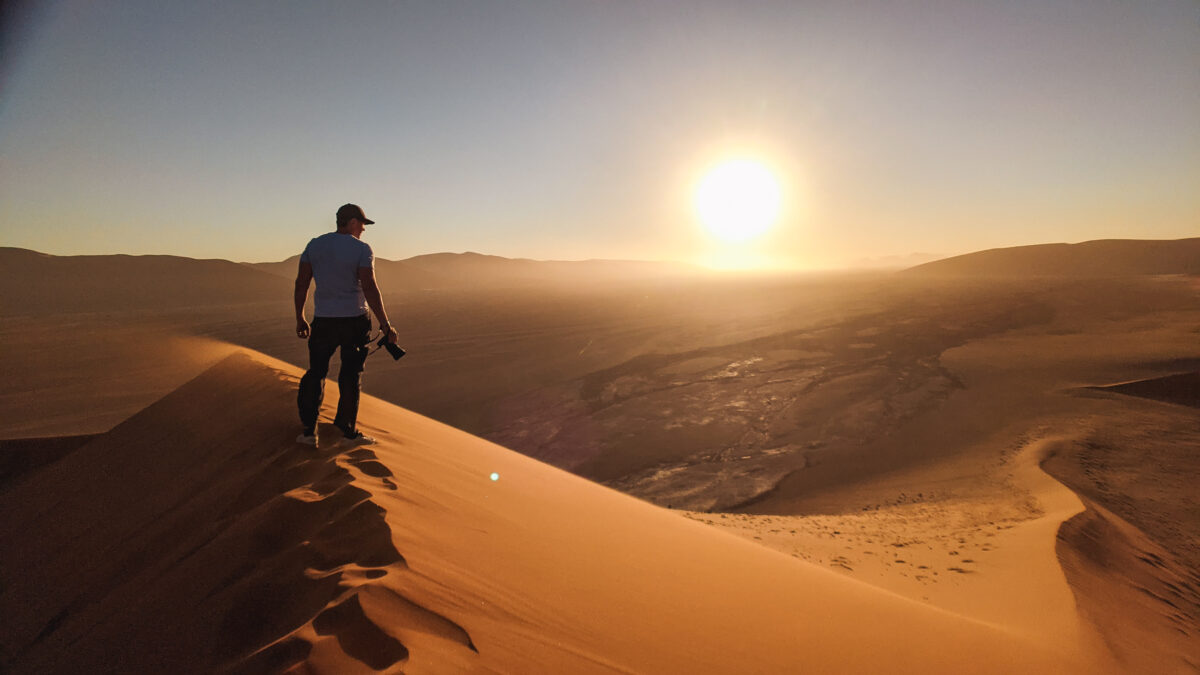
COVID
Before we get started, we need to cover the modern-day basics.
Yes, Namibia is currently open for travel.
Proof of vaccination is not required, however, a negative COVID test is.
All non-Namibian travelers older than five years arriving in Namibia are required to present a negative SARS-CoV-2 PCR test result from their country of departure that is not older than 72 hours, calculated from the time of the sample being taken.
Unfortunately, the African Union recently decided to complicate things.
Effective Wednesday, December 01, 2021, only COVID-19 certificates obtained from providers participating in the Trusted Travel platform or verified on the Global Haven system will be valid for entry into and exit from Namibia.
Basically, this means that they will only accept tests given by approved laboratories. I suppose that helps cut down on fake tests, but was that ever a legitimate problem?
If the traveler meets this requirement, no quarantine or additional testing is required.
VISAS
Most places are good to go. Bearers of U.S. passports who plan to visit Namibia for tourism or informal business meetings for less than 90 days may obtain travel visas at the port of entry free of charge.
Back on Track! My Ultimate Namibia Itinerary!
Day 1: Windhoek
My Namibia itinerary starts in Windhoek, the capital of Namibia, as well as its largest city. It is in the geographic center of the country, and also where most safaris begin. When you fly to Namibia, this is where you’ll be headed.
Namibia as a whole is extremely safe, and Windhoek is relatively safe too, but it’s probably the least so. I had no problems or issues while walking around during the day or night, but there was a sign posted where I was staying that read: “Do not park your vehicle on the street overnight. It WILL be broken into.”
I’ve been in some dicey cities before, but at no point did I feel threatened here. Just ask at the front desk wherever you’re staying if the immediate area is safe. They’ll know.
Many places in Windhoek will offer a city tour if you’re interested. I stayed at Chameleon Backpackers, and this was among their offerings. I passed on this and saw a few of the notable locations on my own such as the unique Christuskirche.
- Rooms at Chameleon Backpackers: $47
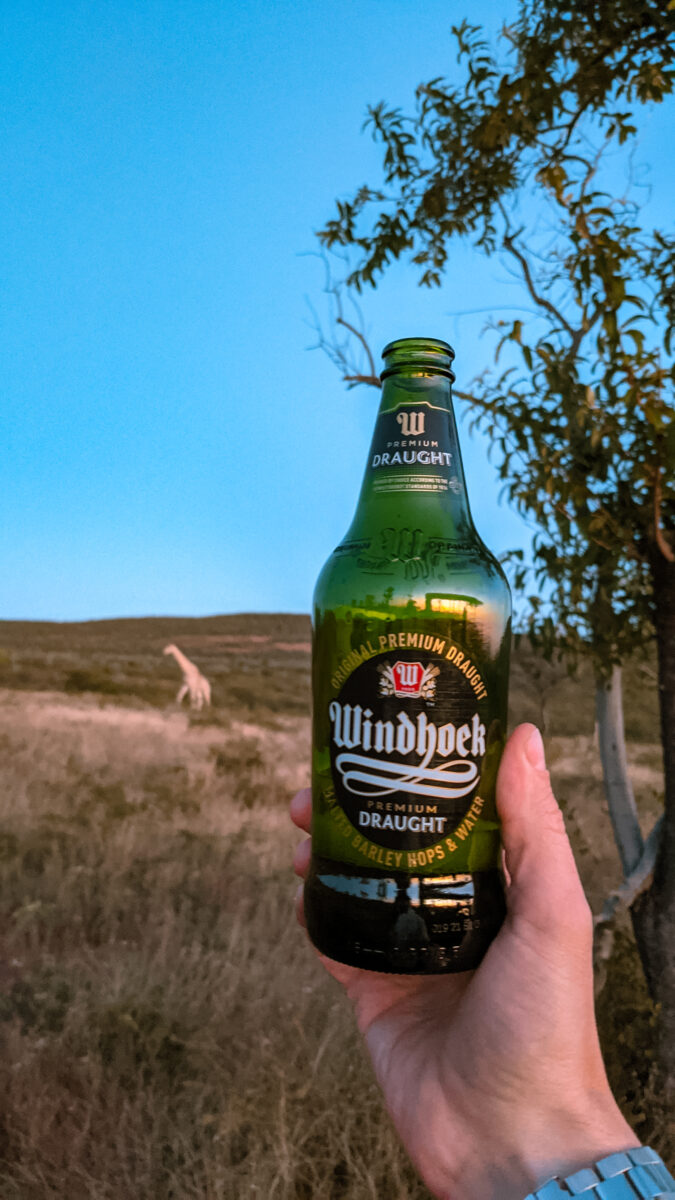
Day 2: Okonjima Nature Reserve
- Windhoek to Okonjima Nature Reserve: 2 hours 15 minutes
My first stop after departing Windhoek was the Okahandja Mbangura Woodcarvers Craft Market. It’s here where woodcarvers from all over Namibia sell their hand-crafted goods.
A heads up to one of their tricks – when they start asking you for names of people you know, it’s because they’re going to run off and quickly carve them into something for you. Then, of course, they’ll guilt you because they went through all of that custom work.
I gave them my brother’s names before I realized something was up. Eventually, I bought two engraved seeds with their names. It was COVID, and I was the only person at this large market, so business was extra slow.
From there, it was on to the Okonjima Nature Reserve.
Okonjima is the location of the AfriCat Foundation. Their mission is the conservation of Namibia’s wildlife in their natural habitat but in a protected conservation area.
Conservation can be a difficult line to walk at times and they’ll tell you all about the ups and downs of their ever-evolving mission over the years. It was very interesting, especially if you’re fond of the big cats.
Here you’ll find leopards, cheetahs, giraffes, and the extremely rare, brown hyenas. I was fortunate enough to see all of them.
I stayed at Omboroko Campsites. They were good campsites with a pavilion and private bathrooms. There is a lodge area that you can visit as well if you’re looking for some non-camp food.
- Campsite at Omboroko Campsites: $45
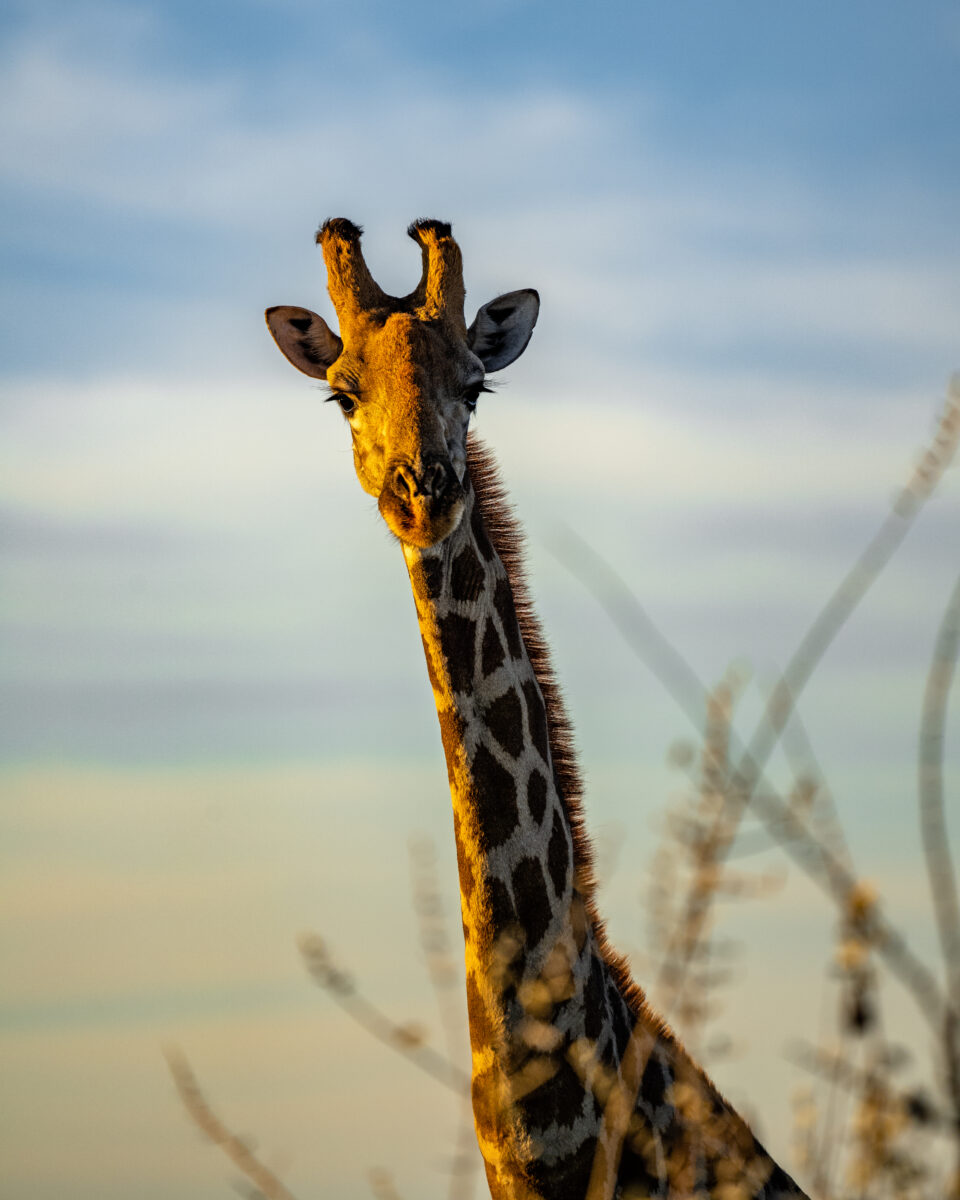
Day 3 – 4: Okaukuejo Campsite, Etosha National Park
- Okonjima to Etosha: 2 hours 38 minutes
Next on the Namibia itinerary, it was on from Okonjima to Etosha National Park.
Etosha is one of the largest parks in all of Africa, and it’s here that you’ll find four of the Big Five animals. The missing species is the cape buffalo which went extinct there in the 1950s because humans suck.
I didn’t see any leopards while I was there, but I saw plenty of lions as well as my first rhinoceros! In fact, I saw lots of rhinos. Granted, lots is a relative term given their critically endangered status. *RHINO HORN IS NOT A MIRACLE CURE FOR ANYTHING. IDIOTS.*
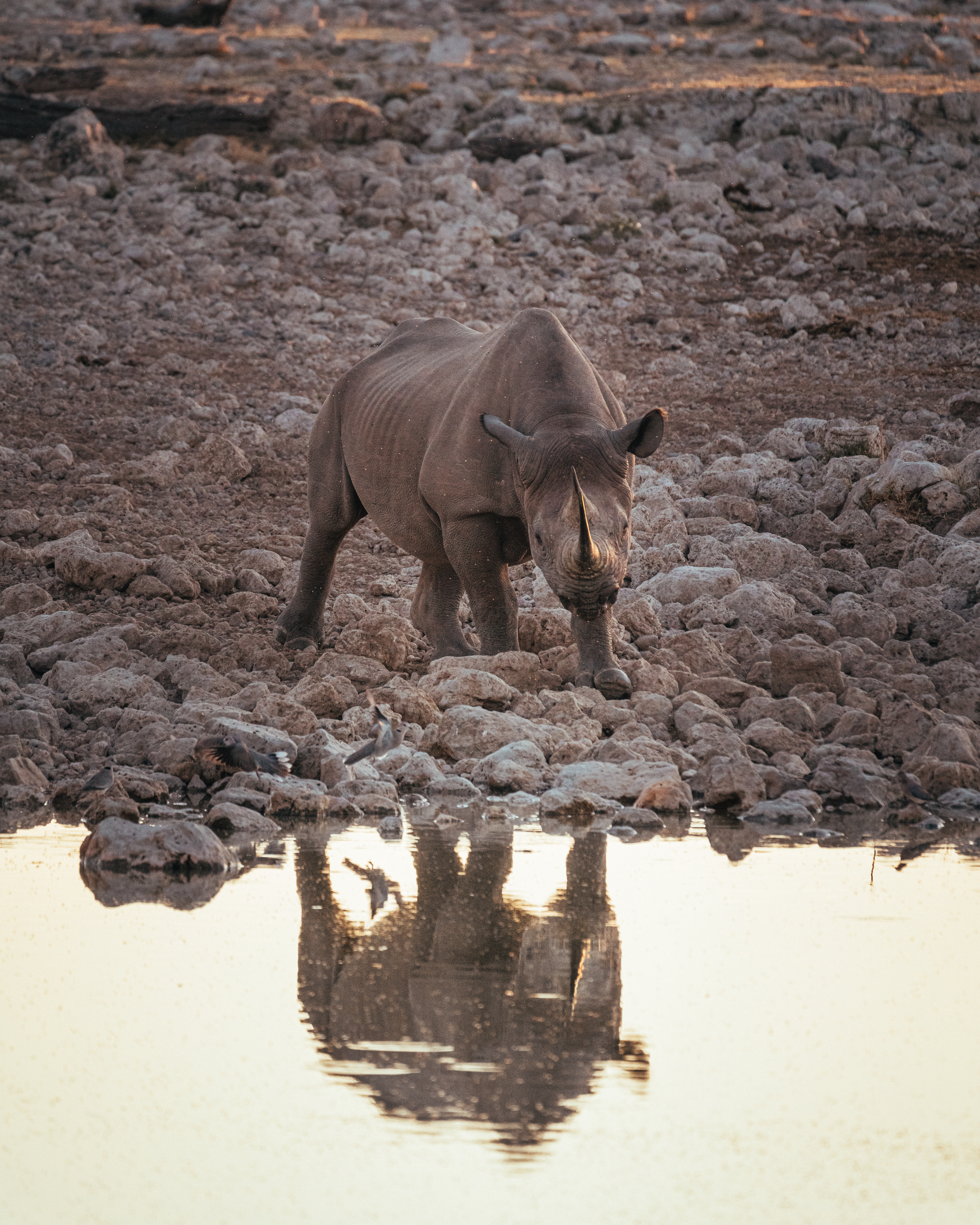
Etosha is also the location of one of the world’s largest salt pans. This pan covers 1,840 square miles and is so large that it can be seen from space!
Finding animals in Etosha is way harder than in some other parks, such as the Serengeti. I attribute this to the types of flora in each, with Etosha having heavy brush while the Serengeti is an open grassland savanna.
Don’t let this discourage you, though; you’ll find some animals eventually. It just takes a bit more work. It also helps if you have a guide like I did. He knew all of the places to look and made a few good spots that I couldn’t see without zooming on my camera.
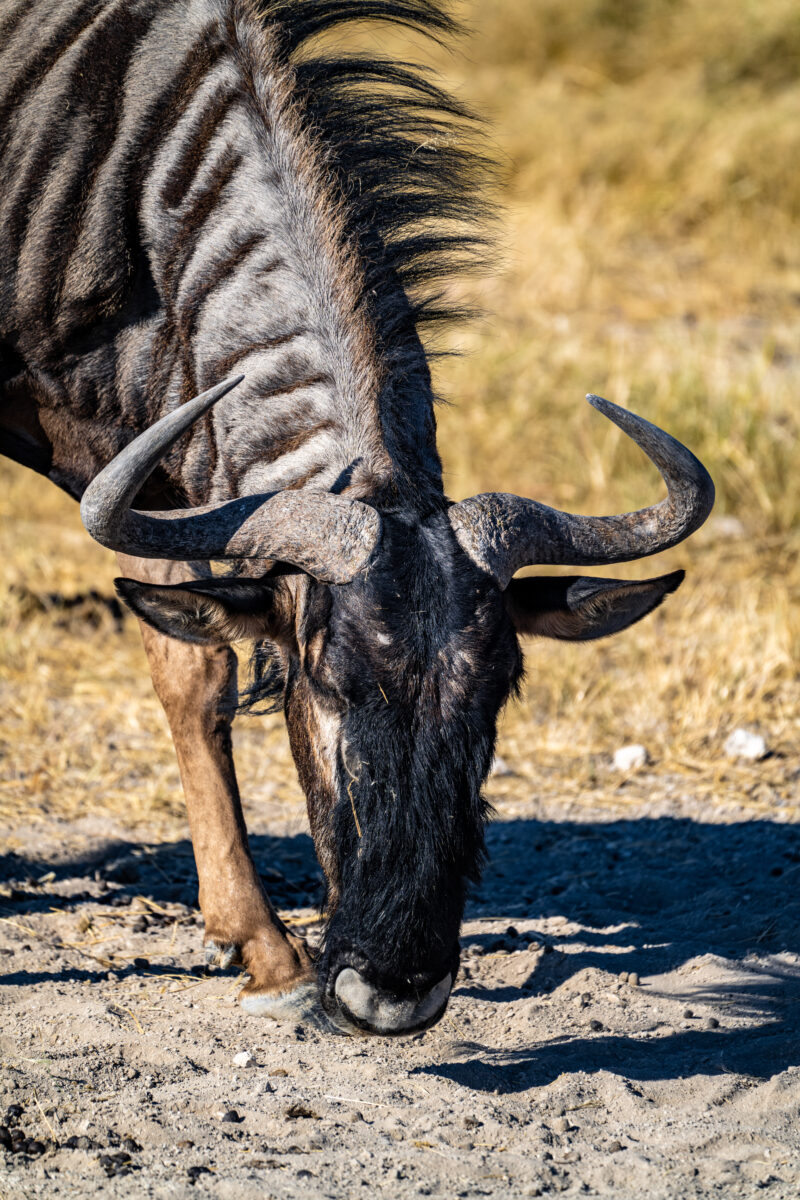
While in Etosha, I stayed at Okaukuejo campsite which is one of several camps located within the park. I can’t speak for the other camps because I never entered them, but Okaukuejo was great due to one particular feature. There is a water hole right next to the camp that attracts everything.
This is where I saw the majority of my rhinos. They come here for a drink just as night begins to fall. You’ll even see lions here if you’re lucky.
I camped like most people, but Okaukuejo has some very nice chalets.
- Campsite at Okaukuejo: $24
- Rooms and Chalets at Okaukuejo: $95 – $300
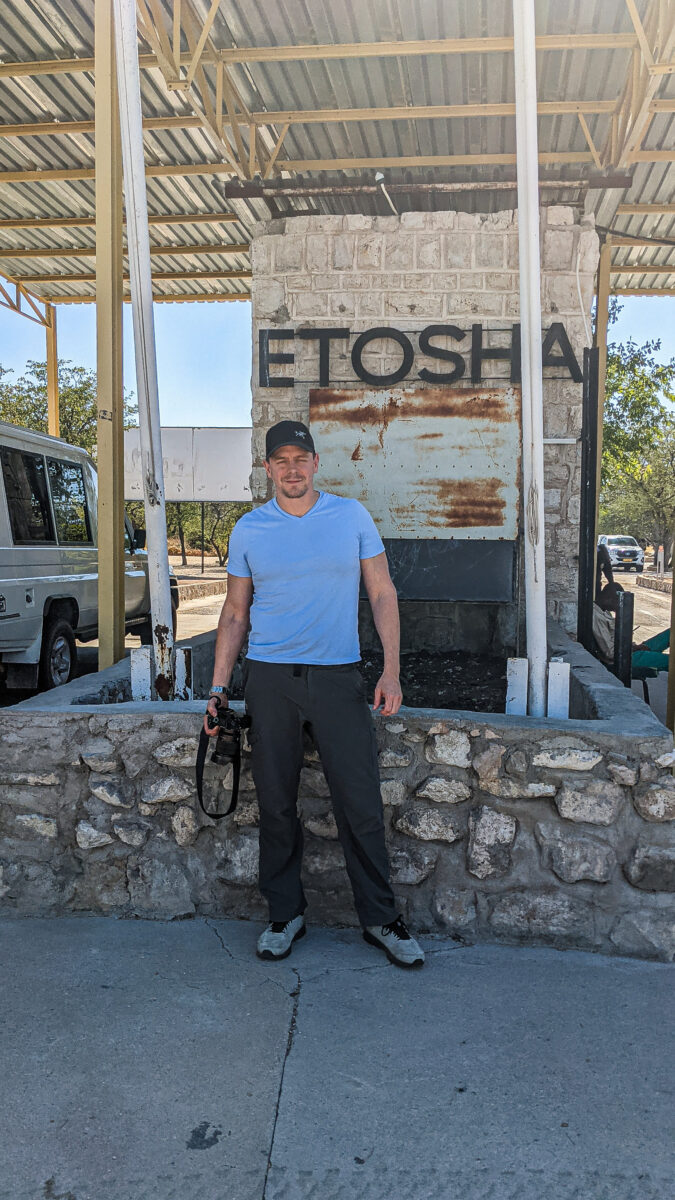
Day 5: Otjikandero Himba Village and Hoada Campsite
- Etosha to Otjikandero Himba Village: 2 hours 10 minutes
- Otjikandero Himba Village to Hoada Campsite: 1 hour
Otjikandero Himba Village
Moving on from Etosha for the Namibian itinerary, it’s off to the Otjikandero Himba Village.
I have read some reviews talking about how it’s a tourist trap or not a real village and that they only come around for tours.
I’ll let you make that decision for yourself, but I went to Namibia during COVID and was the only one to visit for several days. So let me say… this would have been one hell of a production to put on for only one person.
Some of the recurring complaints I saw online were, “It was only the women and children.” Yes, they herd goats, so of course, the (fewer) men were away. “Where are the elderly?!” They’re there. I saw some of them. They’re not on parade and not giving the tour, so it’s not up to them to cater for tourists who they probably have zero desire to see.
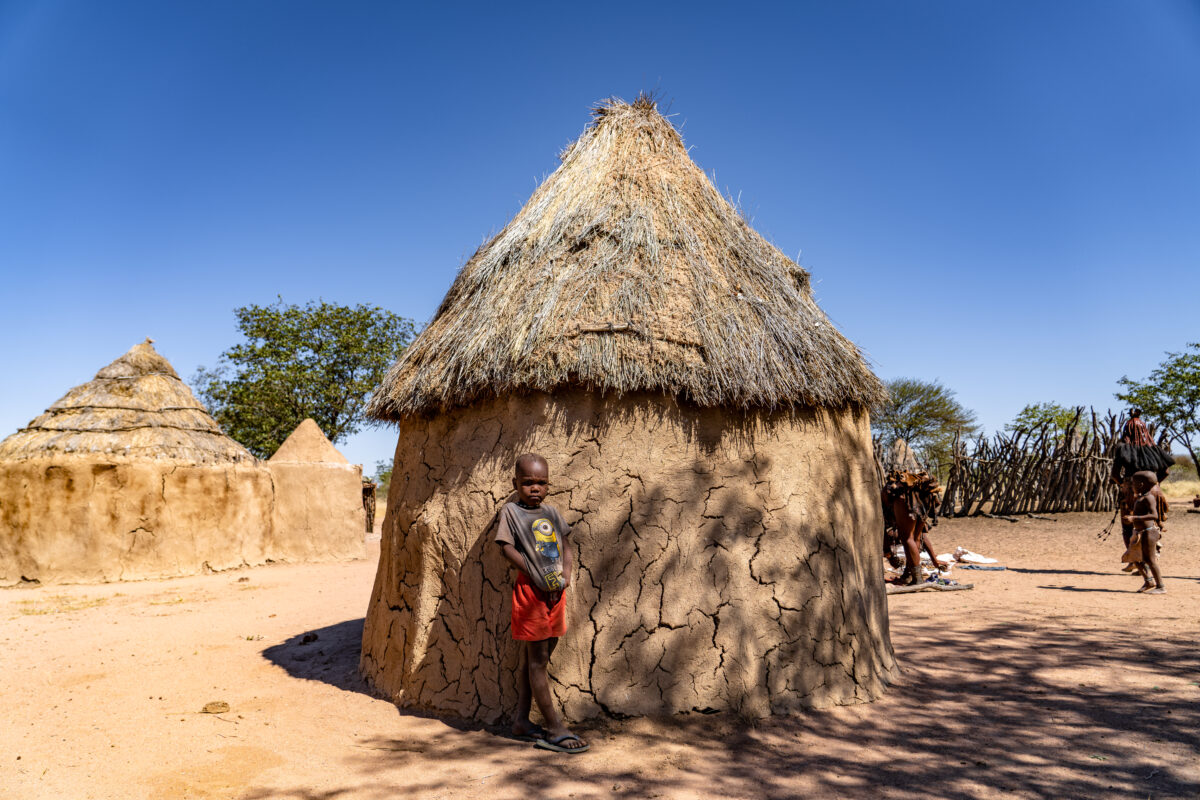
Tour guide not good enough for your high standards? Just tell them that you were entitled to a better experience and ask for a do-over. I’m sure that will go over well. (joking, obviously)
And of course, they’re going to try selling you souvenirs. Many will be things they purchase for resale. I’m sorry that people are so offended that basic concepts of economics have made it to the Himba. Regardless, they still need money for certain necessities, and it’s an easy way for them to boost income beyond goat herding.
Anyway, it’s up to you to decide, but would you rather buy a souvenir from a shop, or from them?
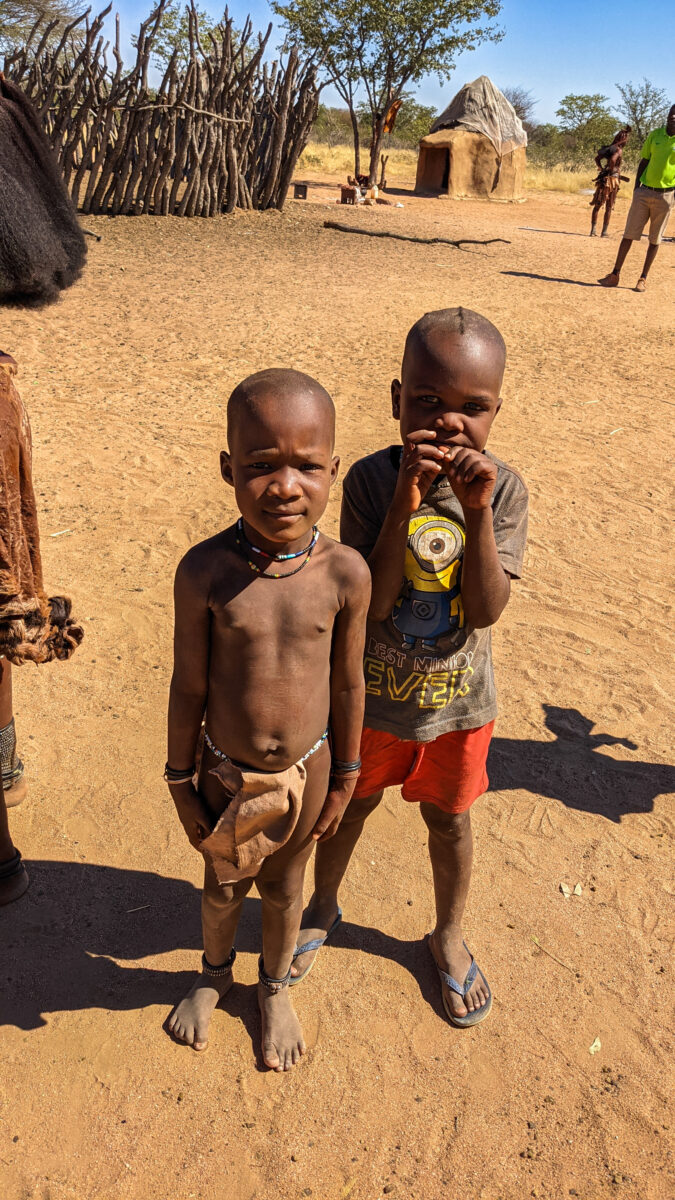
Hoada Campsite
The Hoada Campsite in the Kunene Region where I stayed that night is one of the coolest campsites I’ve been to. This campsite is located amongst massive granite boulders that dot the landscape, stacked in piles.
I even used the coolest shower I’ve ever seen. It was set between two large rocks, tank fed, and required a fire to heat the water!
After you’re settled, you’ll be free to hike around and climb the rocks for a stunning view. I climbed the highest in the area for both sunset and sunrise.
This stop serves more as a waypoint on the very long drive between Etosha and Cape Cross.
Campsite at Hoada: $15
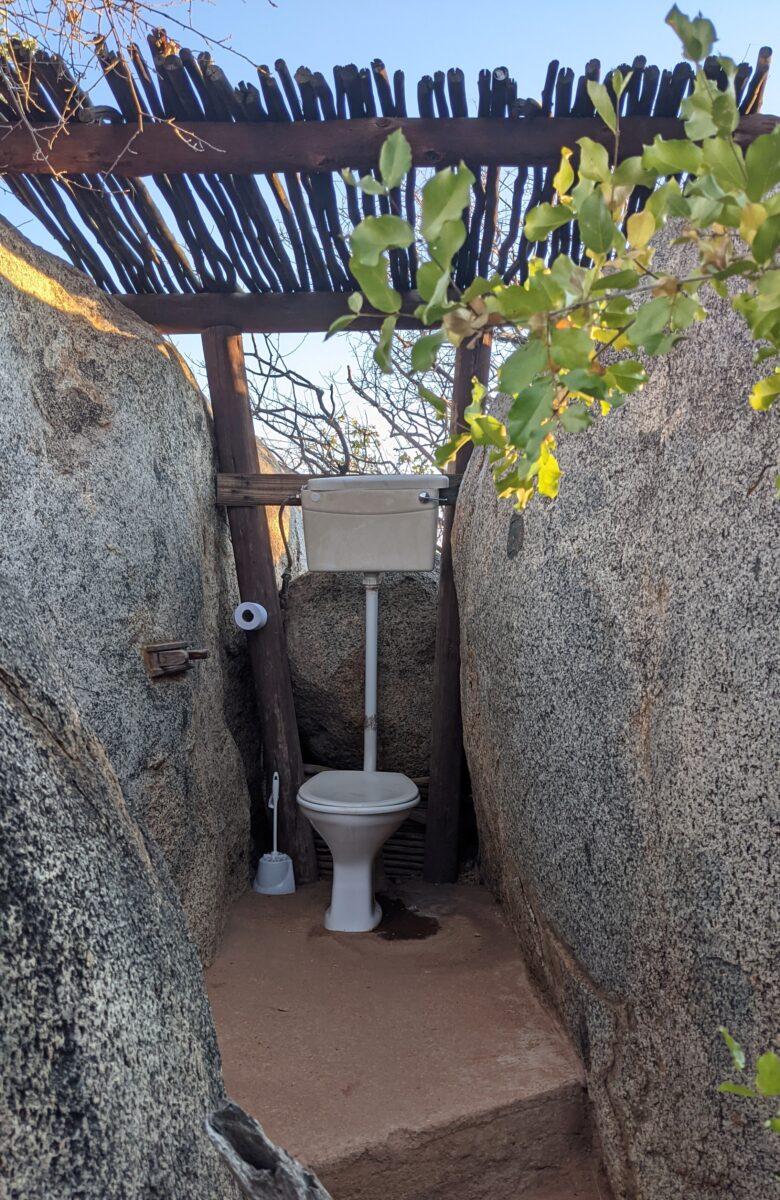
Day 6: Cape Cross – Skeleton Coast
- Hoada Campsite to Cape Cross: 4 hours 45 minutes
From the Hoada Campsite, it’s on to the Skeleton Coast for one heck of a scenic drive.
Ungraded dirt and stone roads are the norm here as you drive along the coastline for several longgg hours.
The Skeleton Coast is very beautiful in its own hostile way, though you won’t see any skeletons other than those of old shipwrecks. The name came from long gone whale and seal bones that use to litter the coastline after shipwrecks deposited a huge mass of them.
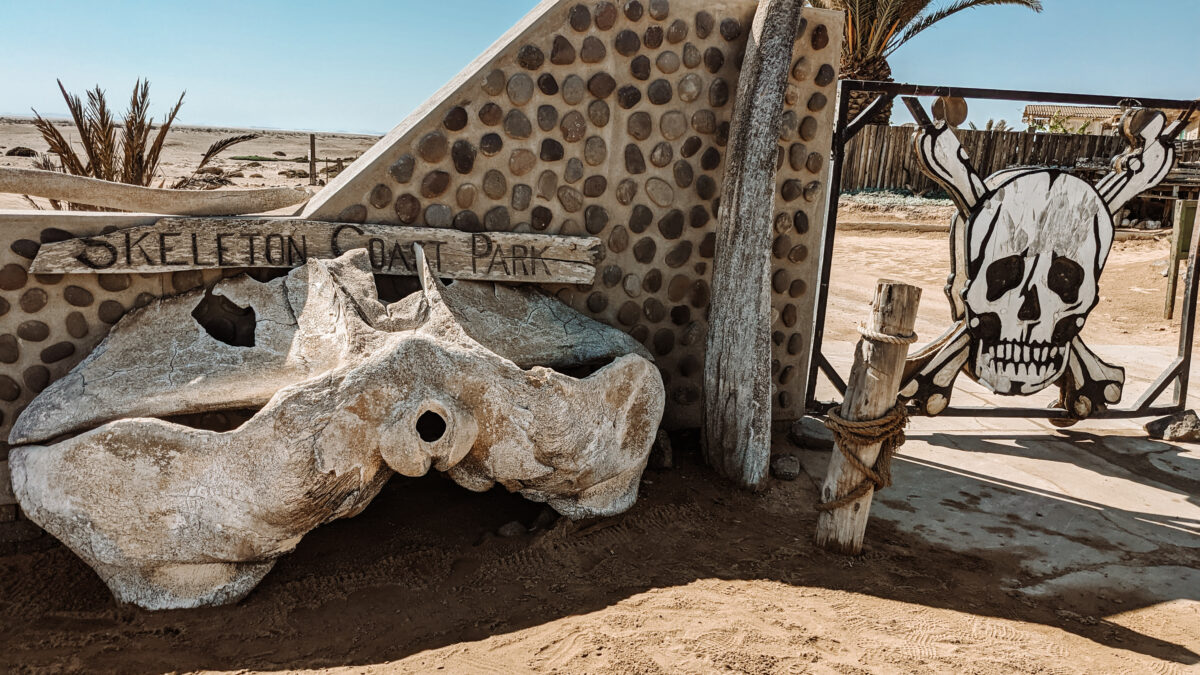
If you are interested in seeing the wrecks, Shipwreck Zeila is one of the most popular, also one of the newest, having only run aground in 2008. You’ll pass right by it as you head down the coast.
Don’t drive through the lichen fields you pass. I know it will look tempting, but the fences are there for a reason. It takes over 100 years for them to recover from the damage a car makes. You’ll occasionally see where some prick drove through them years ago.
I spent the night in Cape Cross at a campsite called Cape Cross Lodge. Points for originality.
The place was completely empty, so I just chilled out and got caught up on my Instagram stories. Unfortunately, you have to pay for slow WiFi in fifteen-minute blocks. Damn, that was annoying.
I did the budget camping again, but the thought of a bed was tempting, so I asked about an upgrade. Since the place was empty, I thought I might be able to score one on the cheap. Unfortunately, one of those rooms still would have cost me several hundred US dollars, so I declined with some amused enthusiasm.
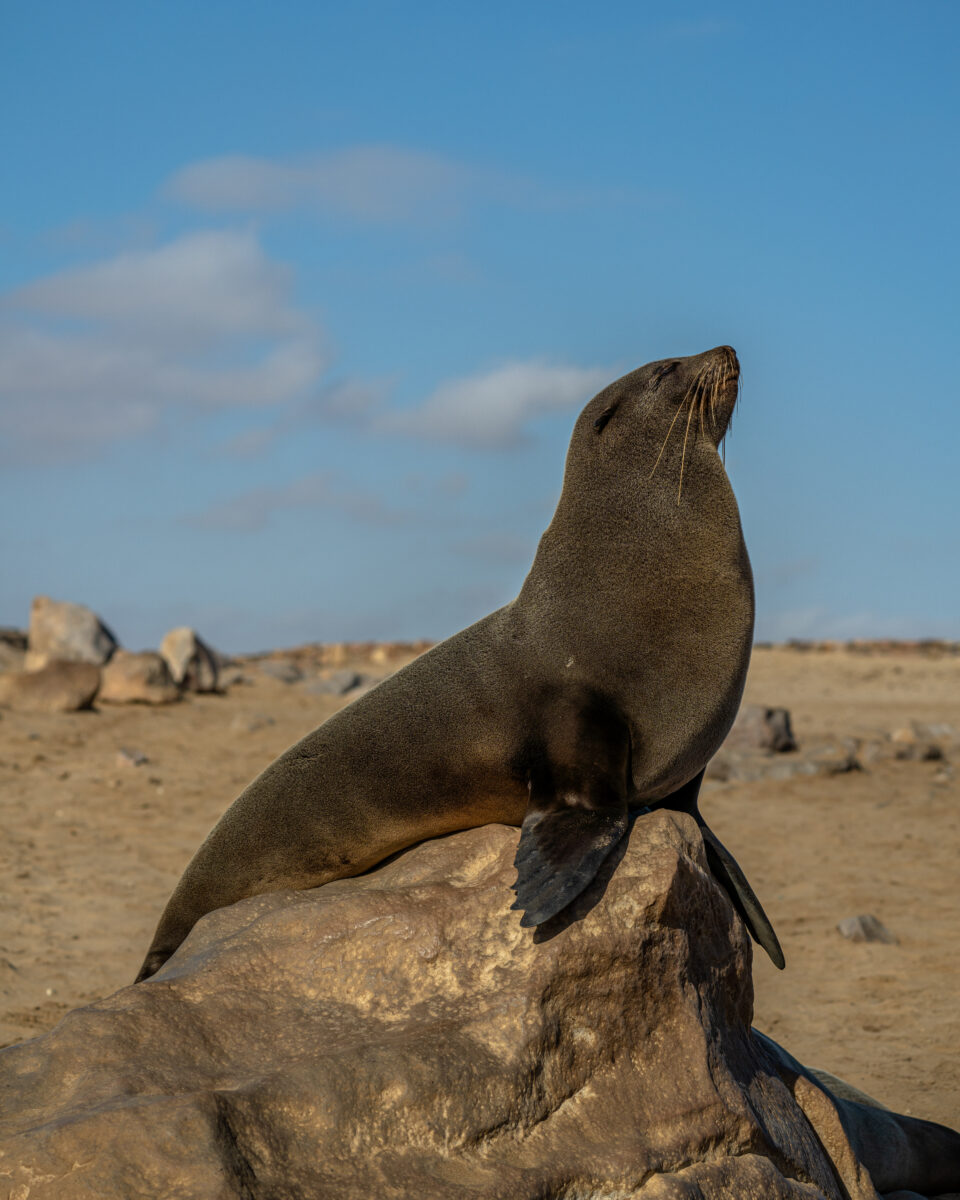
Cape Cross Seal Reserve
After getting settled, make your way a few minutes down the coast to the Cape Cross Seal Reserve. This is the largest Cape Fur Seal colony on the African coast, with over 100,000 seals living there. Sadly, these numbers are way lower than in the past due to overhunting before their protection. Again, go humans… yayyy.
It was really cool seeing them all over the place, especially the ones swimming and riding the waves.
Fair warning, they stink, and they are not nice, so keep your distance because they will charge and bite you if you get too close.
- Campsite at Cape Cross Lodge: $25
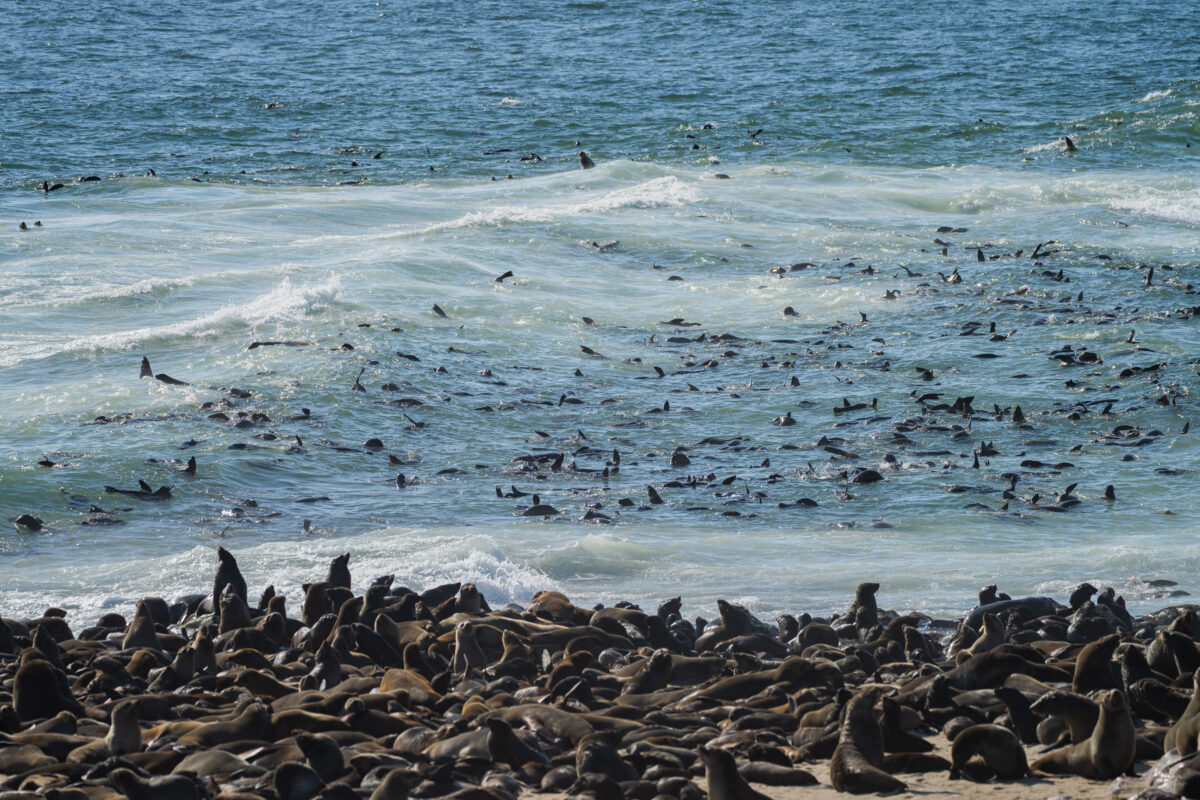
Day 7: SWAKOPMUND
- Cape Cross to Swakopmund: 1 hour 20 minutes
If you’ve watched any of my Instagram stories, then you know that I’m not exactly the best at pronouncing city names on the fly. Pronounced Swa-kop-mund, I spent a minute practicing how to say it before starting on my Namibian itinerary.
After Windhoek, this was the only other city I visited while in Namibia.
It’s a good-looking city, with nice buildings, and a good atmosphere. It was also the only place where I stayed in a real hotel on this trip. The rooms were good, clean, and had heated floors in the bathroom.
The only major downside was that almost everything closed down at around 8:00 PM. I remember going into a restaurant to eat, and when I came out, almost every store was closed, and streets which had just been bustling were now empty.
I looked into this, and apparently, it’s due to the city’s old German roots where this was (is?) a common occurrence.
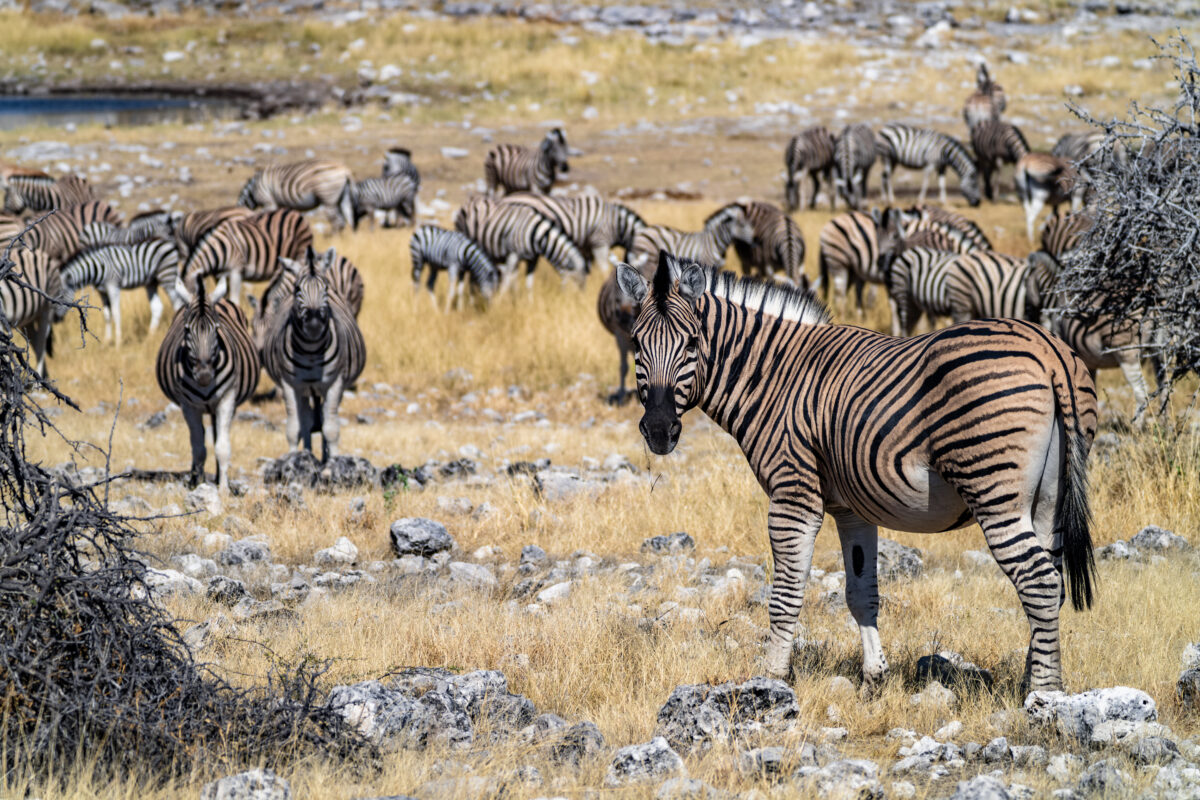
Use this day to decompress and relax in a bit more comfort. There are some local tours available, or, if you’re feeling a bit more adventurous, you can go for an ATV ride in the dunes, or go skydiving. I didn’t start skydiving until a few months after this trip so I hopped on an ATV. I also wanted to sandboard but with a lack of tourists, they weren’t offering it at the time.
As is typical with most ATV tours, they’re going to expect you to play follow the leader. Hang back, get some good distance between you and the pack, and you can let it rip. Even more so if you wait until the others are on the other side of the dune. This was when I started busting out donuts.
Things were going great until I got stuck, and they came back looking for me. In this case, it’s a little hard to lie to cover your tracks when your tracks literally spiral out around you. Oops.
Room at Hotel A La Mer: $85

Day 8 – 9: Sossusvlei
- Swakopmund to Sossusvlei: 5 hours
Etosha or Sossusvlei. I can’t decide which was the highlight of this trip. Both places were absolutely amazing, yet they were completely different from one another. Let me know in the comments which you prefer—the animals of a safari, or the beautiful red sand dunes that stretch beyond sight.
This was another early start to the day, as it should be when faced with a long drive.
Along the way, you’ll be able to make a few memorable stops, the first of which being as you cross the Tropic of Capricorn. Here you’ll be able to get out and take a few pictures with the signs.
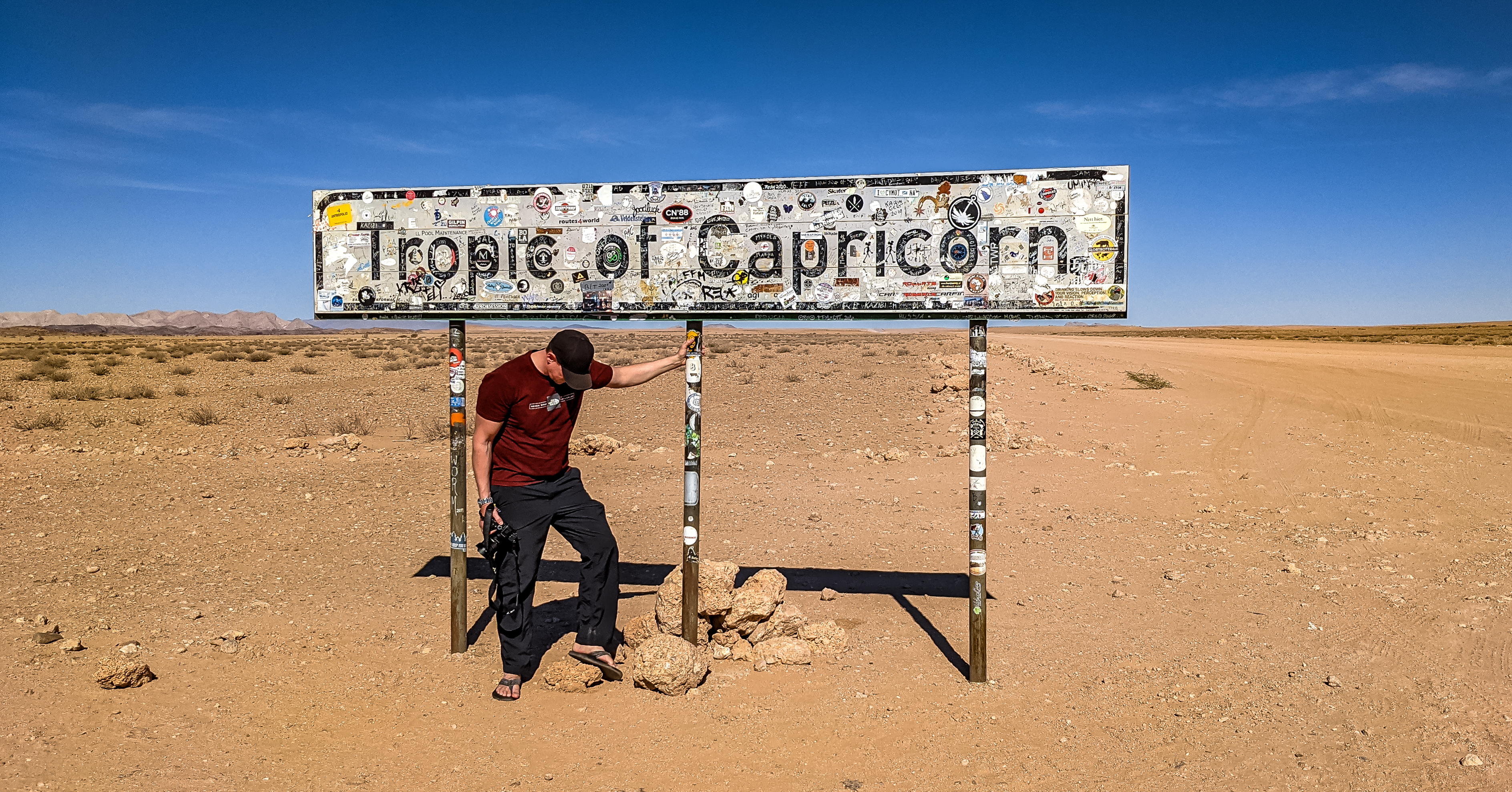
After that, it’s on to the small town of Solitaire. In fact, I have a hard time even calling it a town. It’s closer to a rest-stop like you’d find in an American desert. There’s a gas station, general store, café, and a bakery that’s known for its apple pies. I didn’t try one, but if you do, let me know how it was.
Out front, you’ll see a boneyard of old cars. Since the air is so dry, they don’t rust, so you can get some pretty creative pictures if you have an eye for it. I personally don’t, so here’s a pic of the station, instead of me just standing in front of one, looking awkward.
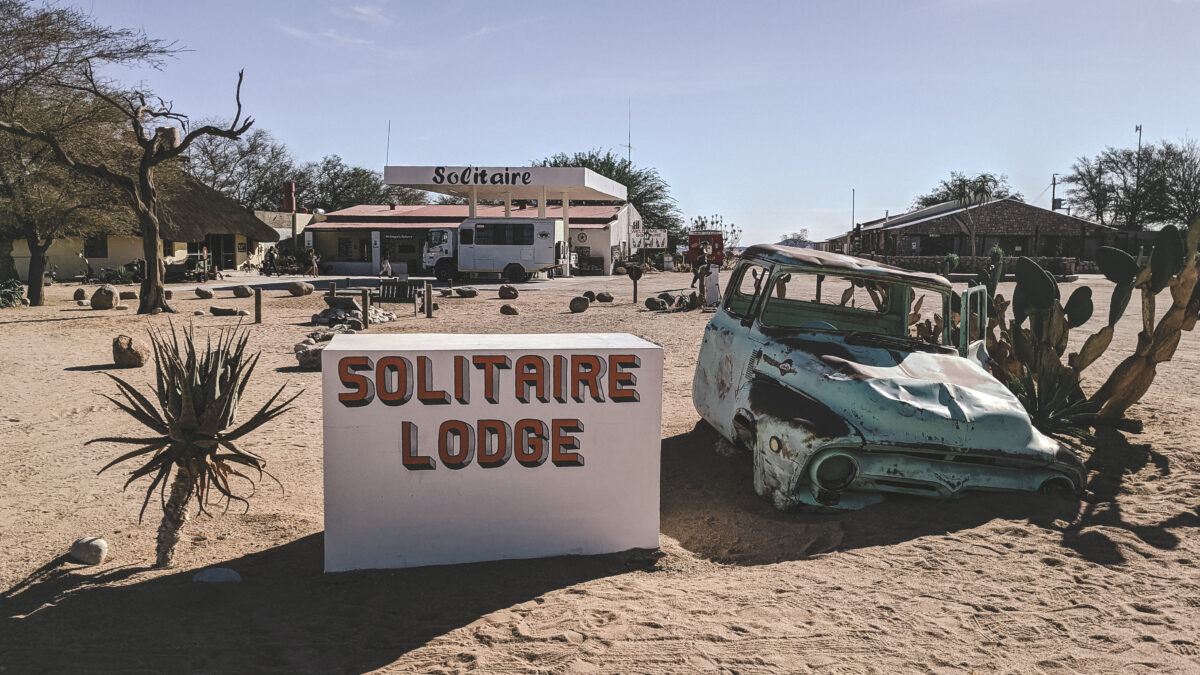
The most important thing in Solitaire is the gas station. With the long, unforgiving roads, and sparse population, especially in this area, always refill your vehicle whenever you have the opportunity. After that, it’s on to Sossusvlei.
Sossusvlei, which is sometimes written Sossus Vlei, is a salt and clay pan surrounded by high red sand dunes.
There is a national park around the area, and you 100% should stay inside the park. The reason for this is that you’ll want to be up and headed to the dunes before sunrise. If you’re outside of the park, you won’t be let in through the gate until 8:00 AM, at which point, it will be too late to scale Dune 45 to see the sunrise.
Dune 45
All dunes in Namibia are numbered based on their location. Of them, Dune 45 is considered to be one of the most photogenic.
Dune 45, a star dune, is located close to the road allowing for easy access. This makes it an incredibly popular climb for the vivid red sunrise.
I climbed it in about an hour, and even though it’s billed as being a relatively easy climb, (the average time is supposedly forty minutes), it was anything but easy. It was so windy that it was like walking through a sandblaster. That, combined with the shifting sand, made for a fierce battle.
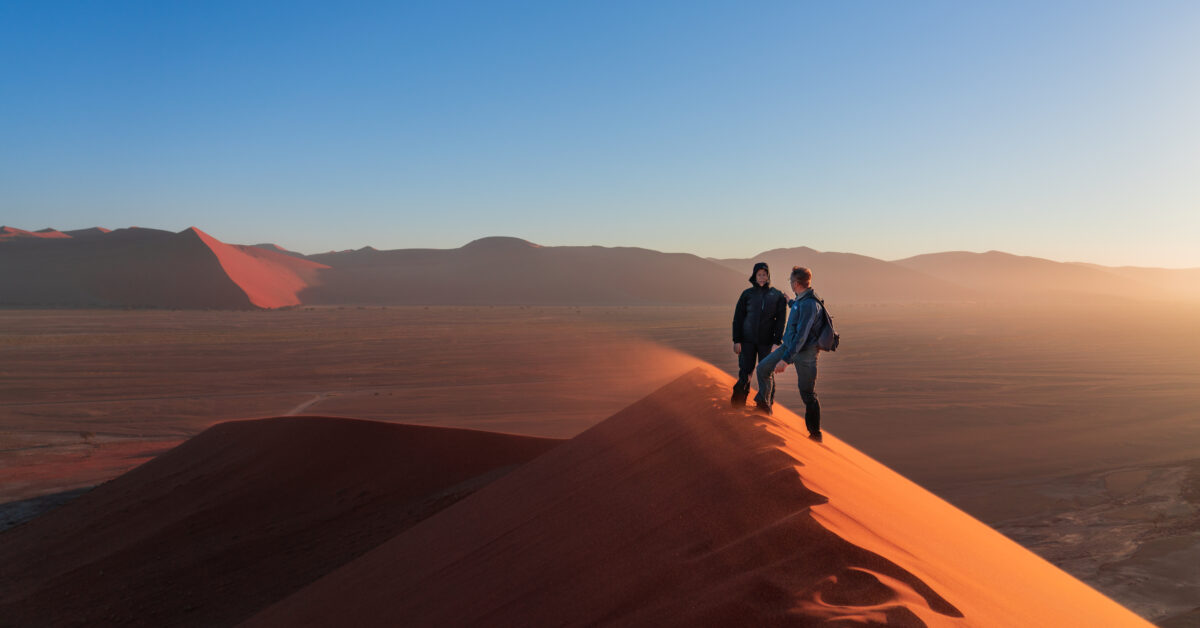
If your feet can handle it, I’d recommend taking your shoes off and going barefoot since their sinking below the sand only to be pulled back through it is tiring. It’s like walking through sugar.
I started climbing with around ten people. In the end, only four of us made it to the top.
The wind might have been relentless, but the second you are below the edge of the dune, the air becomes completely still aside from a gentle rain of fine red sand.
At one point on the way up, I had my hat blown off my head. It went flying over the edge and while shouting “No!” I leaped and sprung after it, only to land in the completely still air.
I thought it was going to be blown a mile away and I’d never see it again. Instead, I had a pretty amusing, “WTF?” moment as it just laid there.
Getting down is much easier than getting up. Now, instead of following the ridgeline, you just cut straight down the side. You can walk it at your own pace in about five minutes, or you can do what I did and sprint down it in under a minute. Running was very fun.
From there, it’s on to Deadvlei.
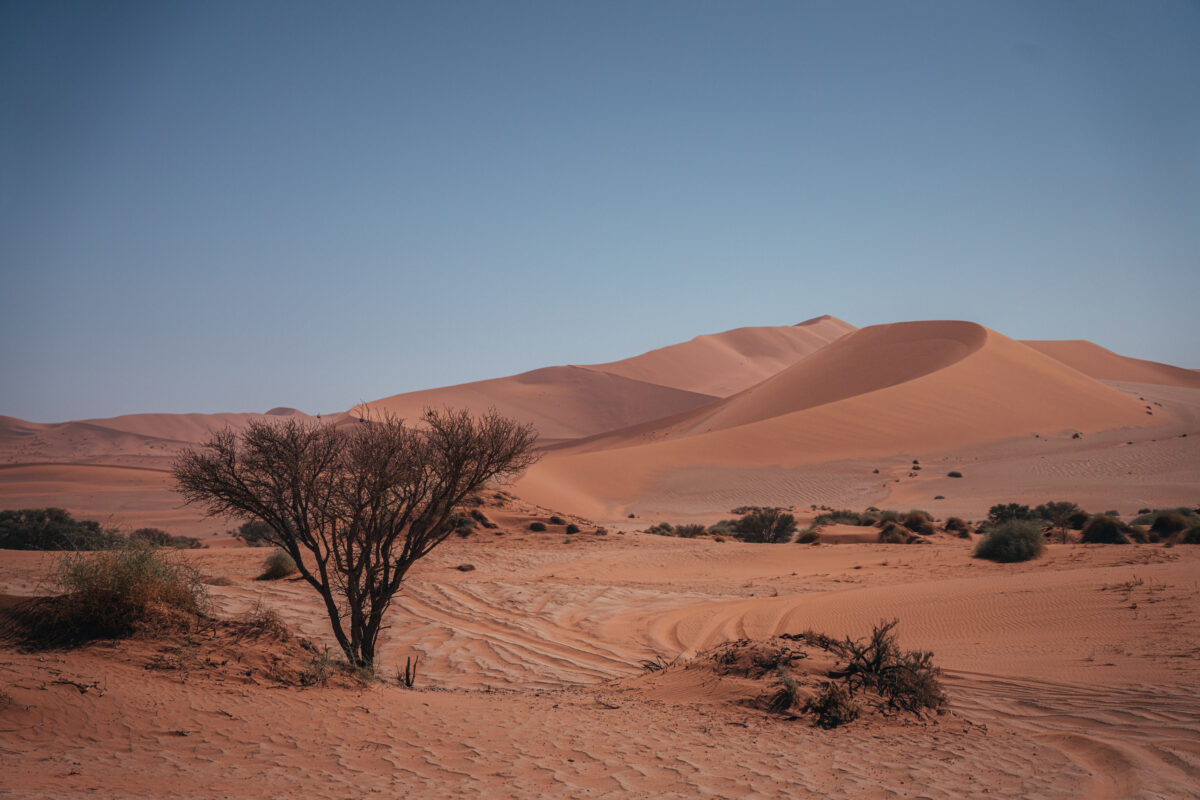
Big Daddy Dune
The first thing you’ll see as you pull up to Deadvlei (either in your own off-road vehicle or in one of the shuttle trucks run by the park) is Big Daddy. This is the highest dune in the Sossusvlei area and wraps around the pan where you’ll find the trees. I had someone ask me which one it was,
Just face straight towards the path to Deadvlei, and it is the dune on the left of the path. You really can’t miss it if you know that it’s the biggest in the area.
Still confused? Look for the dune with people climbing it. There will be several on their way up.
Again, scaling this dune will take most people forty-five minutes to one hour. From the top of it, you’ll be able to get an unparalleled view of Deadvlei. Afterward, you’ll be able to cut straight down the side and right into Deadvlei itself. Same as before, the descent takes about five minutes or less.
I ended up skipping this climb because I wanted maximum time in Deadvlei. Just be sure to climb at least one dune. This would have been the third I climbed in the park.
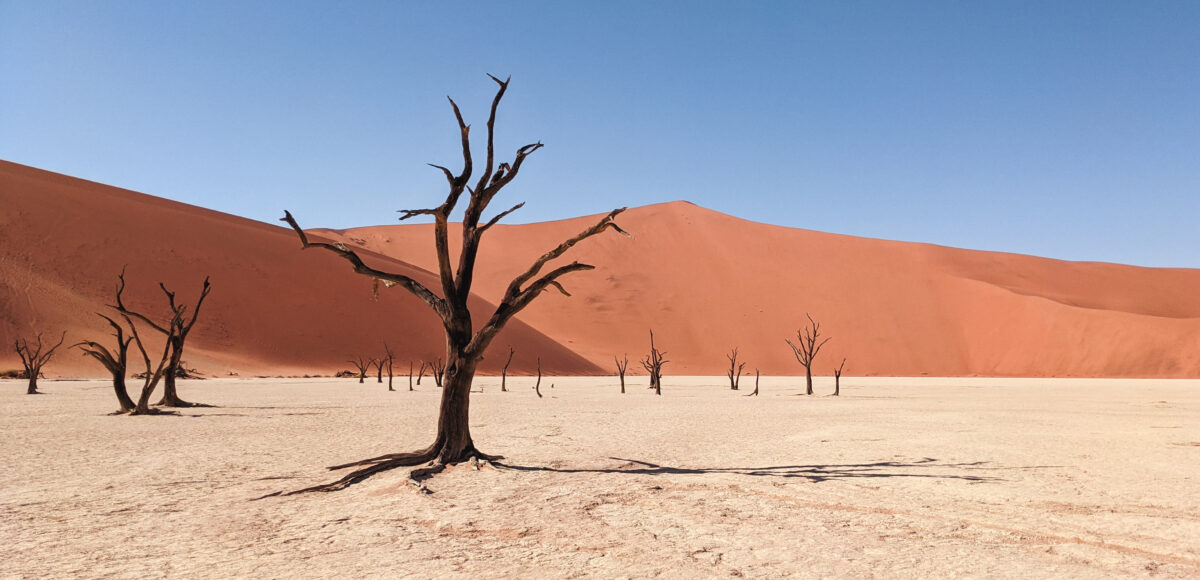
Deadvlei
You may recognize this spot. Have you ever seen pictures of ancient, dead trees in the middle of the desert, and surrounded by a giant sand dune? This is it.
This is such a cool-looking spot! It’s a large clay pan, sheltered by Big Daddy on the left. Inside the pan, you’ll find dead camel thorn trees, which are believed to have died 600-700 years ago. While not petrified, the scorched skeletons of these trees don’t decompose because the area is so dry.
They’re incredibly photogenic. So much so, that pre-COVID, people would show up with a bag of dresses to take as many different pictures as possible. *sigh* Tourists.
On that note, you may be trying to get the perfect picture, but DO NOT touch the trees. Touching is strictly forbidden as they are very fragile.
While I was there, a group of girls went to hang from a branch while someone took their picture. The second her hands touched the branch, about twenty different people, myself included, started yelling at them from all directions. Nothing like a good public dressing-down while you’re on vacation.
I stayed at Sesriem Campsite. Should you decide to camp here, make sure that your tent is completely sealed while you’re inside the park. This is a windy desert with fine sand, and when I got back from Deadvlei, it had blown in through the screen over my door. I had sand EVERYWHERE. It was a nightmare to clean up.
Campsite at Sesriem: $33
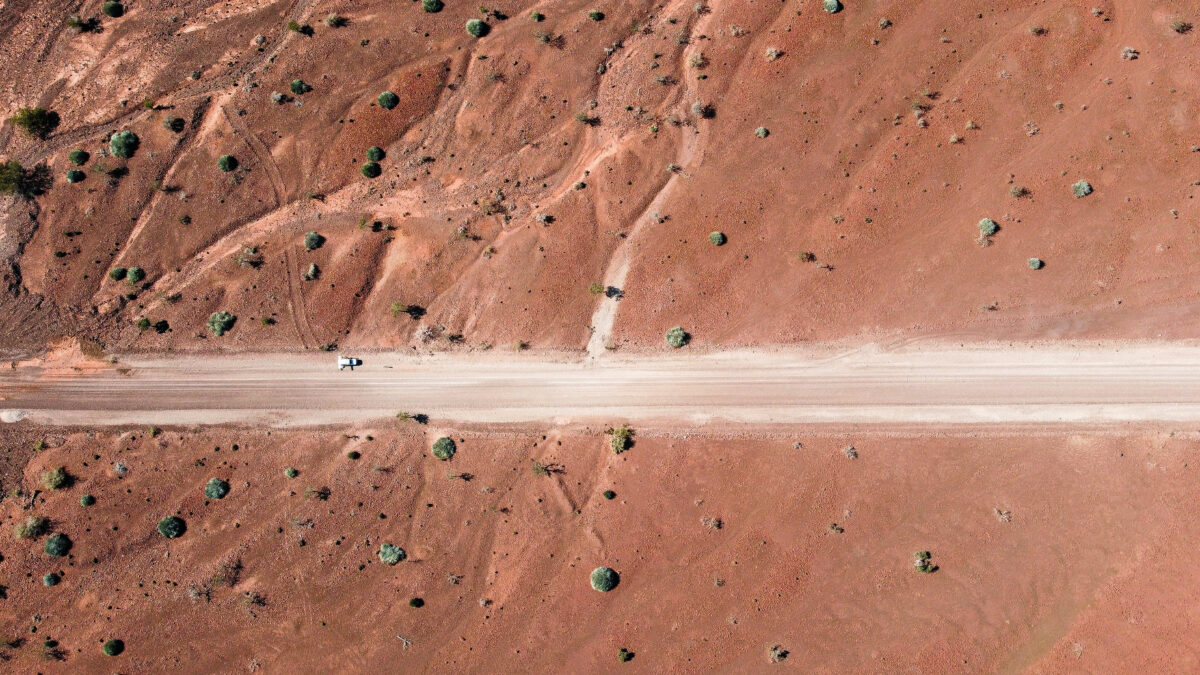
Day 10: Windhoek
- Sossusvlei to Windhoek: 4 hours 45 minutes
Back again, back again.
Your trip is pretty much over at this point, so Day 10 is just a drive back to Windhoek. There are a few cool views worth checking out, but nothing too crazy. I only stopped to put up my drone a few times to get some “Driving through the desert” footage.
You’ll drive through Solitaire again as well as a few of the more populated areas.
This was also when I got my COVID test. I booked it in advance through my initial hotel, Chameleon Backpackers. The test was taken in a portable lab (built in a shipping container) that had been parked along the highway near Windhoek. It was a drive-up, drive-out test and I received my results that night.
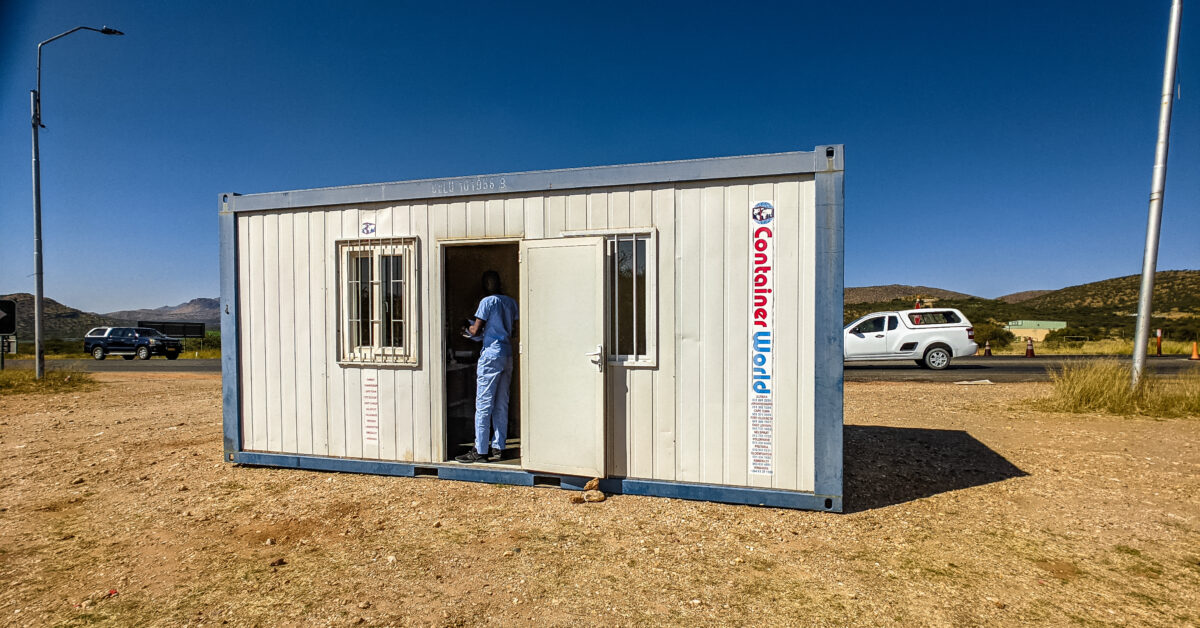
Preemptive Advice
The most important thing you should know about any Namibia itinerary is that under no circumstances should you be driving at night.
Driving at night in Namibia is considered to be extremely dangerous and is highly discouraged. As odd as it may sound, the road is one of the favorite places for animals to spend the night as it stays warmer for longer.
Throw in their natural camouflage on the bad, unpaved roads, and boom.
I know you’re already thinking, “Pfft, that’s nothing. I’ll drive at night.” (I know I was.) Mention that to a local and you’ll get a death stare like no other. Nobody drives at night. Seriously.
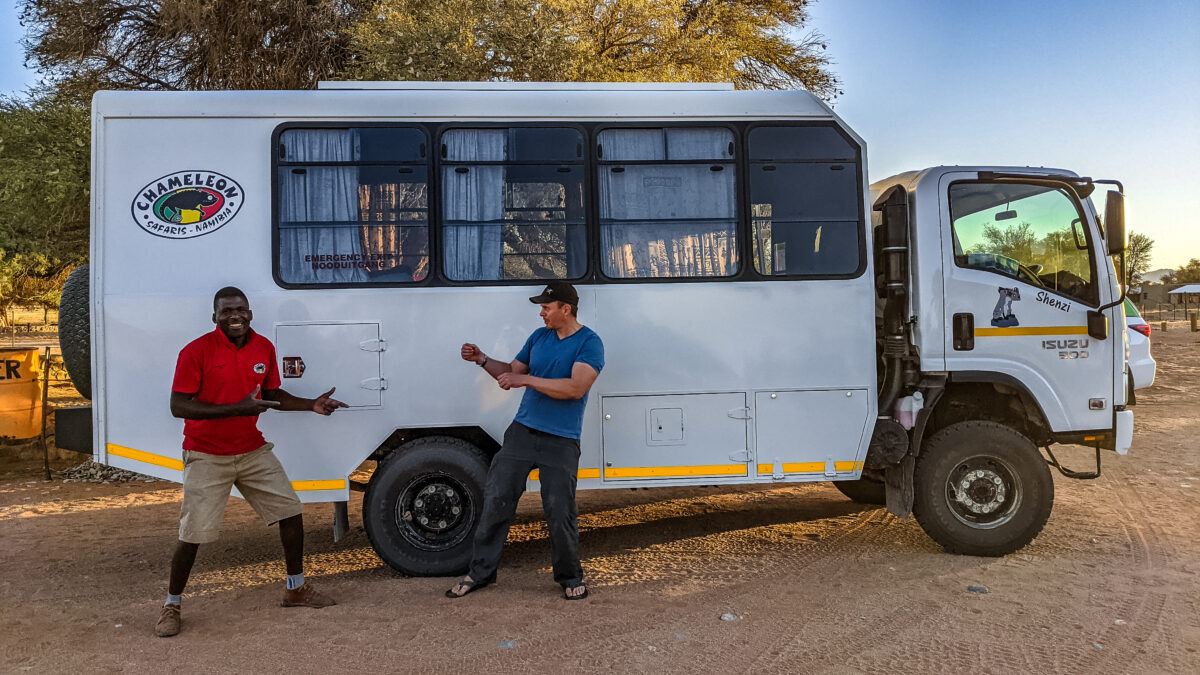
Ranking 8th, Namibia is one of the least densely populated countries in the world. So should worst come to worst? You’ll be stranded and many hours away from any emergency services. Plus there are the more mundane accidents, like flat tires. I got two on these roads. Wouldn’t have wanted to change them in the dark.
So what do you think about my Ultimate Namibia Itinerary for Ten Days? Is this something you’d like to take on? It’s well worth it!
DID YOU ENJOY THIS ARTICLE? PIN IT!
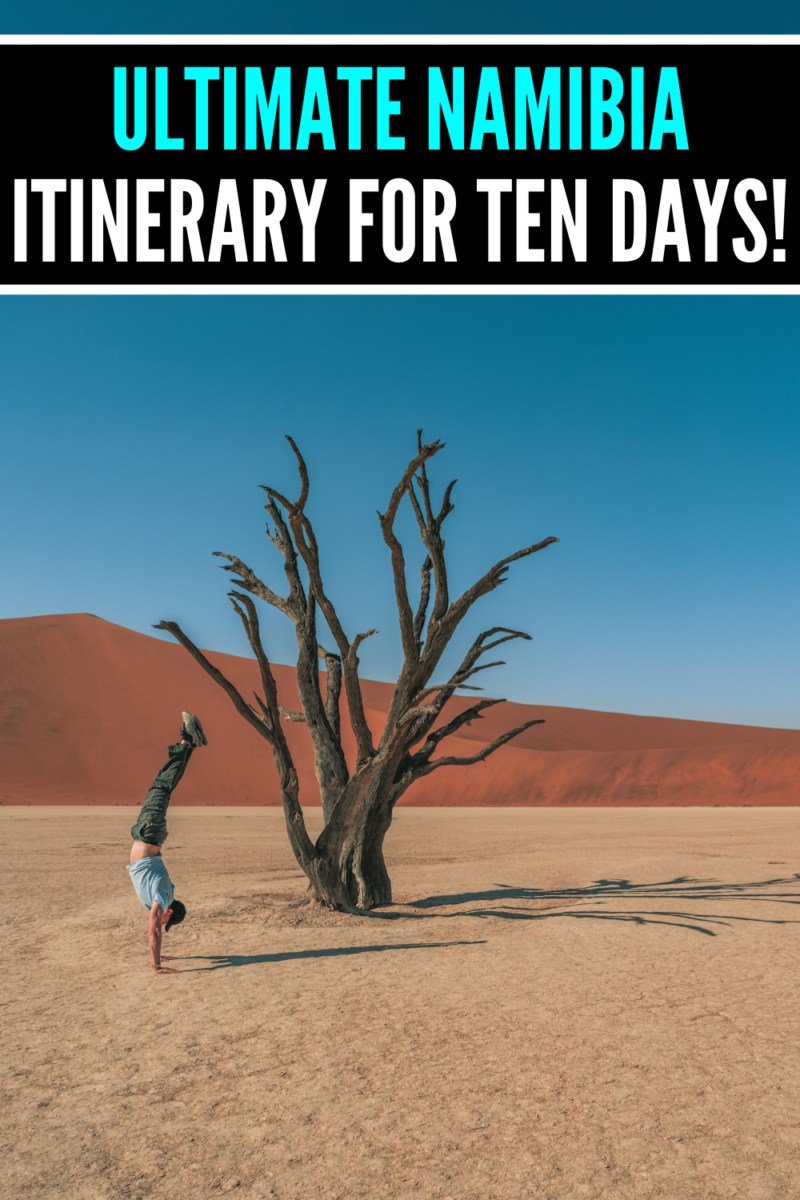
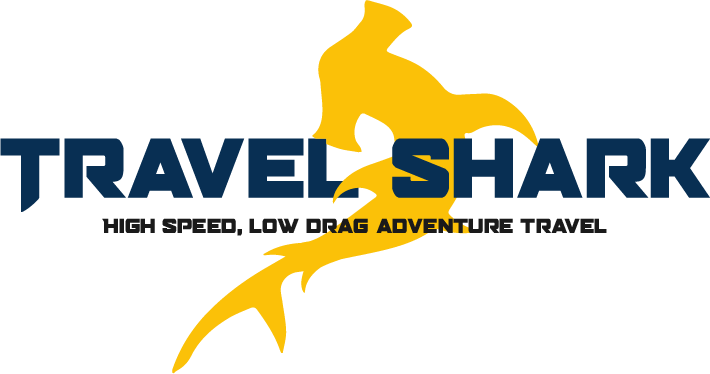
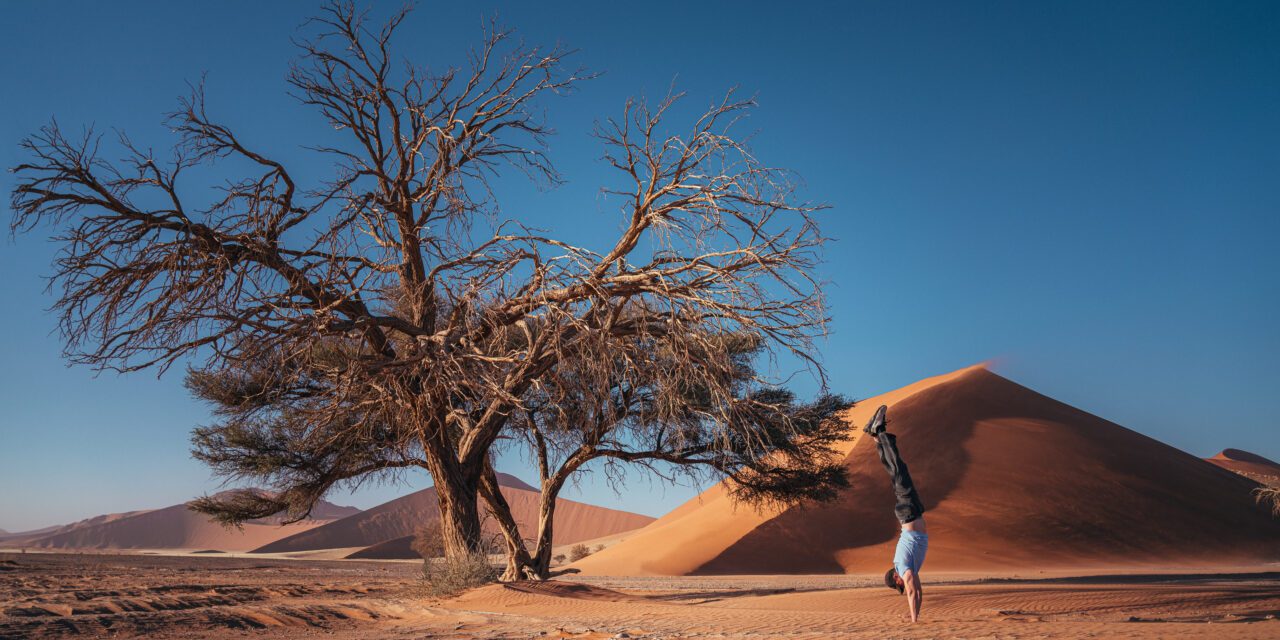
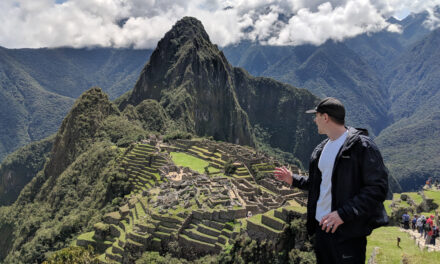
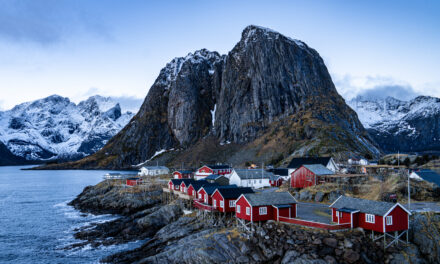
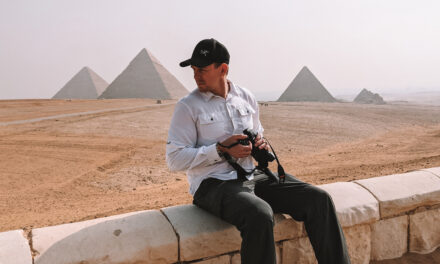
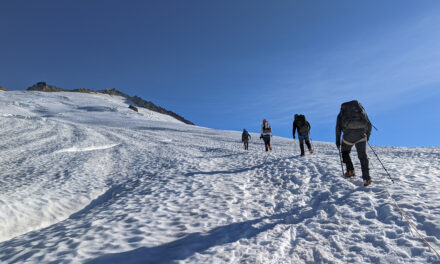
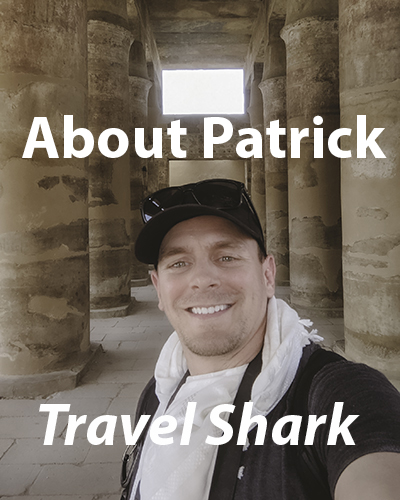
Omg this is so awesome. Thank you so much for this very DETAILED blog.
You’re very welcome! These guides take a little longer to write, but are so worth it! 🙂
Africa is such a beautiful place! I have wanted to go to Namibia since I learned about it in High School. It has to be such an amazing experience. I loved reading through this. I do have a question. I have read and heard mixed things online about women traveling to Africa. If I were to do something similar to your adventure, do I have to be concerned about anything or avoid certain areas? The toilet in Hoada is a bit concerning! LOL
Yes! Namibia is so beautiful and amazing. The scenery there is out of this world. It’s so diverse.
For the most part, Namibia is a safe country to visit. Windhoek is probably the least safe place in the country but you’ll probably be getting right out of there when you visit. That’s where the muggings and bag snatching are most likely to happen. I personally had no problems, nor did anyone I met while there. As always, execute common sense with where you’re walking.
[…] favored the big cats, particularly tigers, tracking rhinos is usually at the top of my list on any safari I take. Maybe it was the difficulty I experienced in finding them early in my travels, but whatever the […]
[…] My flight to Namibia, and then back to the USA from Botswana took 40 and 38 hours each. Yes, my flights technically took up two full work weeks lol Layovers were involved, but that’s still a lot of time to be traveling from point A to point B. […]
[…] to Africa have always been expensive, but the current global situation has only made things […]
[…] going to Namibia? Oh, I’m only going to Myrtle Beach.” I always stop them and tell them not to think […]